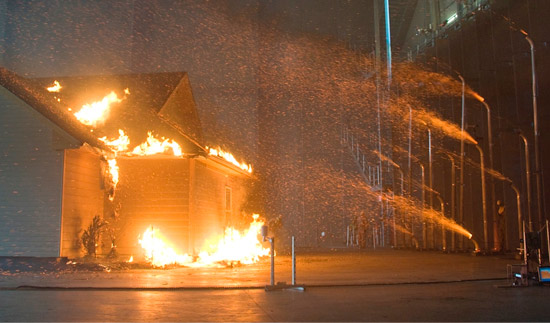You can learn a lot when you break things. For the construction and insurance industries, testing buildings to destruction in a controlled and repeatable environment can be particularly revealing, and there are several facilities around the world in which this can be done. I'm going to talk about some that focus on wind engineering.
The Wall of Wind (WoW) at the Florida International University (of which AIR is a sponsor) can simulate a Category 5 hurricane supplemented with wind-driven rain. WoW is capable of simulating atmospheric boundary layer wind and aims to be as influential to wind engineering as crash testing was to the automobile industry. Structures and products are tested with the ultimate goal of achieving sustainable communities and large reductions of property loss and insurance costs. Recommendations made as a result of testing at WoW were published in the 2010 Florida Building Code, which went into effect in 2012.
Most wind testing facilities, including WoW, generate atmospheric boundary layer straight-line winds, but the WindEEE Dome in Ontario, Canada-a unique hexagonal wind tunnel-can generate tornado-like flows as large as 6m in diameter to simulate the equivalent of F3 Enhanced Fujita Scale intensity winds. The impact of non-synoptic wind systems (such as tornadoes and down bursts) on buildings and structures is a challenging subject of investigation in wind engineering and the WindEEE facility is providing very useful insight.
The Insurance Institute for Business & Home Safety (IBHS) Research Center in South Carolina is wholly funded by the property insurance industry, and savings on natural disaster-related losses are the expected return on the investment. As part of Verisk Insurance Solutions, AIR was one of the founding members.
The Center works in partnership with manufacturers, trade groups, government agencies, and academic institutions to improve product and system testing standards, increase the availability of reliable and affordable retrofit options, investigate the durability and resiliency of sustainable building technology, and evaluate the potential for building technologies to reduce property losses. Catastrophe-related issues, especially with regards to residential and commercial roofs-the first line of defense against most natural hazards-are a particular focus.
The Center has outdoor specimen construction and aging areas and an exceptionally large wind tunnel test chamber. It is 145 feet square, and is tall enough to accommodate two-story structures. Thanks to a battery of 105 fans, test structures can be subjected to a variety of realistic hazards, including high-speed gusty winds (up to Category 3 hurricanes), wind-driven rain, hail, and wildfire ember attacks.

An IBHS test for the U.S. Department of Homeland Security's "Wildfire Ignition Resistant Home Design" program showed how embers, rather than direct flame contact, can cause buildings to burn during wildfires.
(Source: United States Department of Energy)
Generally, test structures are a mix of conventional construction and those with various mitigating features. Strategically placed sensors enable pressures and forces at numerous locations within them to be measured precisely and multiple cameras are installed. Because they are placed on a 55-ft. diameter turntable, the structures can be turned remotely during testing to alter wind direction if required.
The Center dramatically demonstrates the effectiveness and affordability of better-built structures to residential and commercial building owners and other stakeholders.
To read more about physical testing, check out this AIR Currents article.



